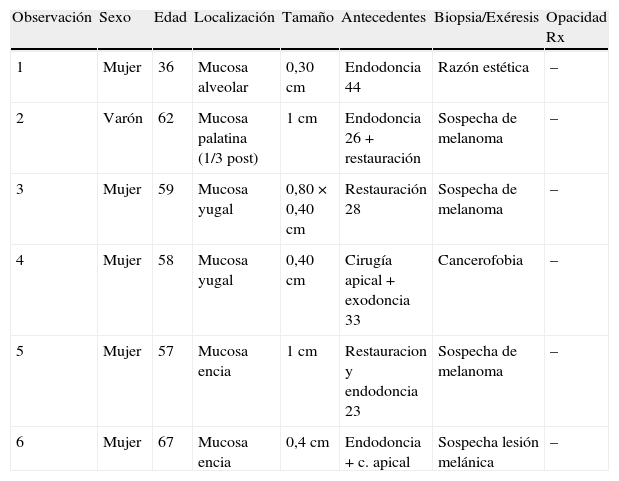El tatuaje por amalgama, la pigmentación exógena oral más frecuente, puede en ocasiones simular lesiones melánicas y ser motivo de estudio biópsico. Se presentan las características clinicopatológicas de 6 pacientes (5 mujeres y un varón) biopsiados por pigmentación oral por amalgama. La localización más frecuente fue la mucosa gingival, seguida de la yugal y palatina. La morfología y distribución (estromal, perivascular, perineural y endomisial) de la pigmentación fue variable, apreciando solo en un caso reacción capsular fibrosa e igualmente, solo en un caso, reacción granulomatosa tipo cuerpo extraño. Esta variabilidad morfológica esta condicionada por la cuantía y cronología del depósito pigmentario, que a menudo esta asociado a una infiltración por mastocitos (CD117+), así como a una sobreexpresión de metalotionina y HLA-DR a diferentes niveles tisulares.
Amalgam tattoo, the most common exogenous oral pigmentation, can sometimes be confused with melanotic lesions, being then biopsied. We present the clinicopathological characteristics of 6 biopsied cases (5 females and 1 male) of oral amalgam pigmentation. The most common location was the gingival mucosa, followed by the buccal and palatal mucosa. Morphology and distribution (stromal, perivascular, perineural, endomysial) of pigmentation was variable; there was only 1 case with fibrous capsular reaction and likewise only a single case of granulomatous foreign body reaction. Morphological variability is conditioned by the timing and amount of the pigment deposit, which is often associated with infiltration by mast cells (CD117+), as well as overexpression of metallothionein and HLA-DR at different tissue levels.
Artículo
Comprando el artículo el PDF del mismo podrá ser descargado
Precio 19,34 €
Comprar ahora










